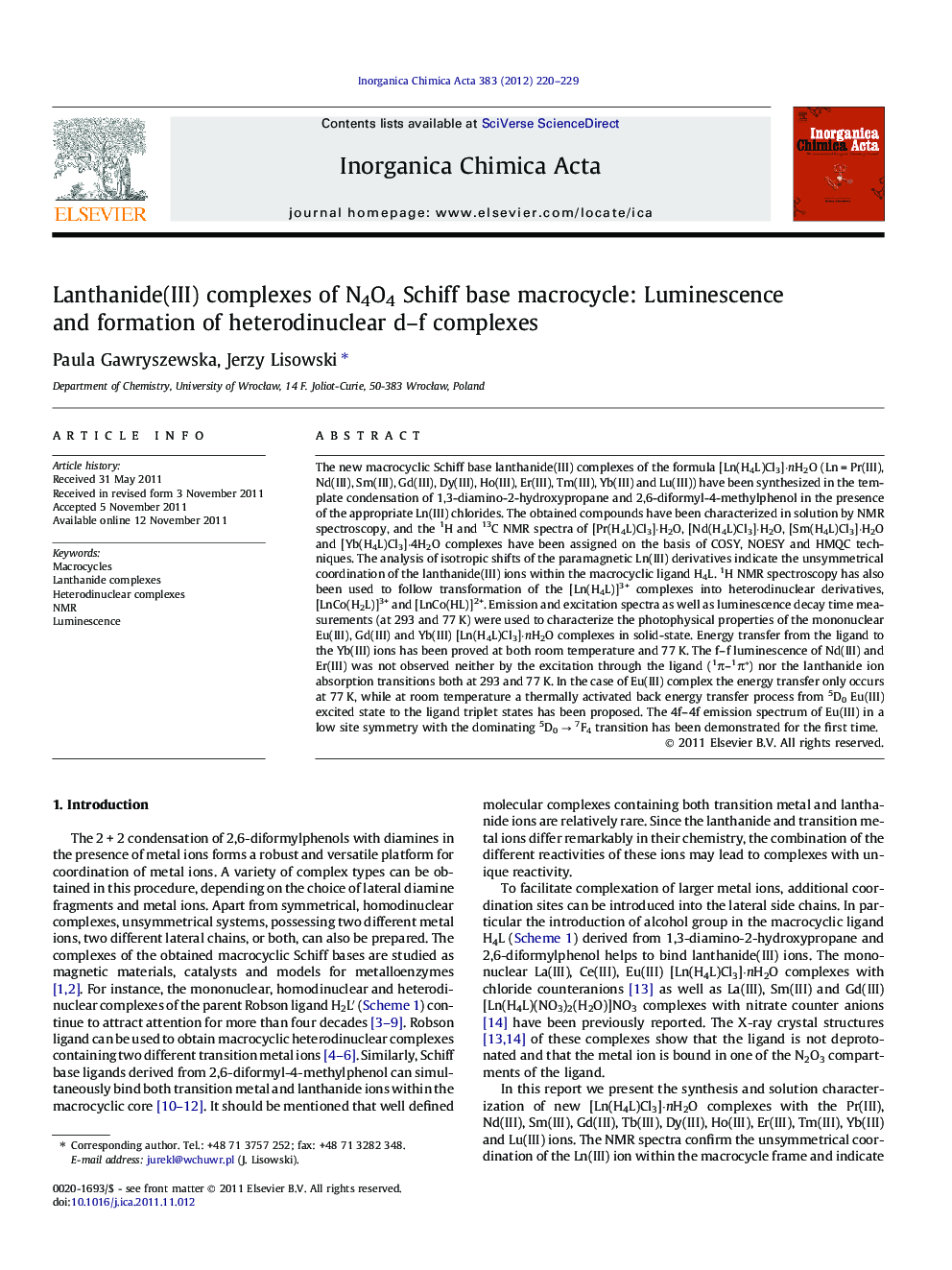| کد مقاله | کد نشریه | سال انتشار | مقاله انگلیسی | نسخه تمام متن |
|---|---|---|---|---|
| 1312497 | 1499204 | 2012 | 10 صفحه PDF | دانلود رایگان |

The new macrocyclic Schiff base lanthanide(III) complexes of the formula [Ln(H4L)Cl3]·nH2O (Ln = Pr(III), Nd(III), Sm(III), Gd(III), Dy(III), Ho(III), Er(III), Tm(III), Yb(III) and Lu(III)) have been synthesized in the template condensation of 1,3-diamino-2-hydroxypropane and 2,6-diformyl-4-methylphenol in the presence of the appropriate Ln(III) chlorides. The obtained compounds have been characterized in solution by NMR spectroscopy, and the 1H and 13C NMR spectra of [Pr(H4L)Cl3]·H2O, [Nd(H4L)Cl3]·H2O, [Sm(H4L)Cl3]·H2O and [Yb(H4L)Cl3]·4H2O complexes have been assigned on the basis of COSY, NOESY and HMQC techniques. The analysis of isotropic shifts of the paramagnetic Ln(III) derivatives indicate the unsymmetrical coordination of the lanthanide(III) ions within the macrocyclic ligand H4L. 1H NMR spectroscopy has also been used to follow transformation of the [Ln(H4L)]3+ complexes into heterodinuclear derivatives, [LnCo(H2L)]3+ and [LnCo(HL)]2+. Emission and excitation spectra as well as luminescence decay time measurements (at 293 and 77 K) were used to characterize the photophysical properties of the mononuclear Eu(III), Gd(III) and Yb(III) [Ln(H4L)Cl3]·nH2O complexes in solid-state. Energy transfer from the ligand to the Yb(III) ions has been proved at both room temperature and 77 K. The f–f luminescence of Nd(III) and Er(III) was not observed neither by the excitation through the ligand (1π–1π∗) nor the lanthanide ion absorption transitions both at 293 and 77 K. In the case of Eu(III) complex the energy transfer only occurs at 77 K, while at room temperature a thermally activated back energy transfer process from 5D0 Eu(III) excited state to the ligand triplet states has been proposed. The 4f–4f emission spectrum of Eu(III) in a low site symmetry with the dominating 5D0 → 7F4 transition has been demonstrated for the first time.
Lanthanide(III) complexes have been obtained in a template condensation of 1,3-diamino-2-hydroxypropane and 2,6-diformyl-4-methylphenol. The 4f–4f emission spectrum of Eu(III) in a low site symmetry with the dominating 5D0 → 7F4 transition has been demonstrated for the first time. NMR spectra of the paramagnetic complexes indicate that only one of the macrocycle compartments can be occupied by the Ln(III) ion. These mononuclear complexes can be converted to heterodinuclear complexes containing Ln(III) and Co(II) ions, as well as into homodinuclear Co(II) complex.Figure optionsDownload as PowerPoint slideHighlights
► A series of new mononuclear lanthanide(III) complexes of compartmental N4O4 macrocycle are obtained.
► NMR of paramagnetic complexes indicate that only one of the two compartments can be occupied by Ln(III).
► Eu(III) exhibit unprecedented luminescence spectrum with untypical intensities.
► Heterodinuclear Ln(III)–Co(II) complexes can be formed.
Journal: Inorganica Chimica Acta - Volume 383, 30 March 2012, Pages 220–229